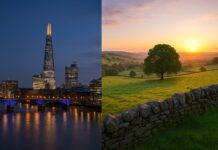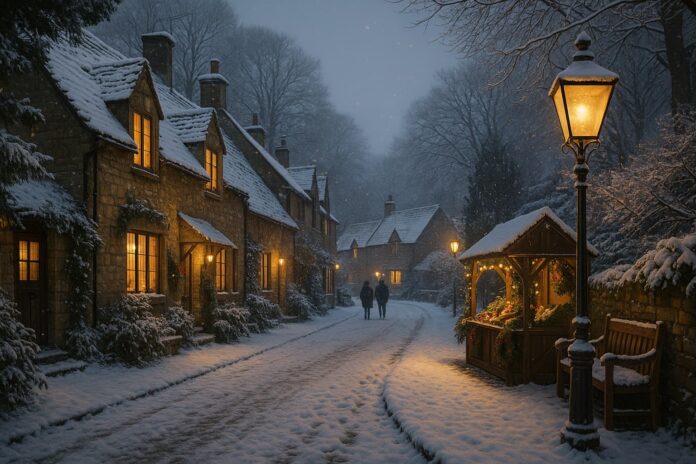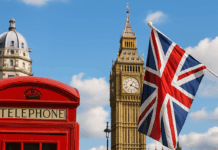When winter arrives in the UK, the landscape transforms into a charming tapestry of frosted hills, glowing high streets, festive markets, and roaring fireplaces. Rather than staying indoors waiting for spring, winter invites you to explore its seasonal beauty in meaningful and memorable ways. Whether you prefer adventure, creativity, romance, or pure comfort, the colder months offer countless experiences that warm the heart.
From scenic steam train journeys and winter wildlife walks to indulgent hot chocolate crawls and charming Christmas markets, winter in the UK has something for everyone. This guide brings together many of the most delightful and comforting winter activities perfect for couples, families, friends, and solo explorers. Settle in, grab a warm blanket or a steaming mug of tea, and prepare to discover 14 cosy winter activities across the UK worth trying this season.
Introduction
Winter in the UK is more than short days and crisp temperatures—it is a season filled with enchanting traditions, tranquil moments, and opportunities to create memories that linger long after the frost melts. The UK’s diverse landscapes, from the Welsh valleys and Scottish Highlands to the countryside of England and the dramatic Irish coast, provide a beautiful backdrop for winter explorations. The season may bring chilly weather, but it also brings festive lights, roaring fireplaces, steaming winter menus, and an invitation to slow down.
Many people associate winter with hibernation, yet this season presents unique and meaningful ways to connect with nature, history, food, and culture. From winter spa retreats and candlelit cathedral carols to coastal walks and stargazing in famous dark sky reserves, winter transforms ordinary activities into extraordinary experiences. With the right clothing and a sense of adventure, the season feels full of possibility rather than limitation.
1. Visit Magical Christmas Markets Across the UK
Christmas markets are among the UK’s most beloved seasonal traditions, transforming town squares, city centres, and historic courtyards into vibrant festive villages. Stalls glow with warm lighting, craftsmen display handmade items, choirs perform seasonal carols, and the aroma of roasted chestnuts, mulled cider, cinnamon pastries, and gingerbread drifts through the air. These markets have deep roots in European history, yet the UK has refined the tradition with its own cultural influences.
Christmas markets are not only places to shop—they are social environments where winter feels alive and full of joy. Couples wander hand in hand, families enjoy rides and festive workshops, and visitors browse locally produced candles, woollen goods, preserves, and artisan decorations. Many markets now feature boutique chalets run by independent creators, meaning visitors support small enterprises while finding gifts with meaning.
Some of the most iconic markets include:
- Bath Christmas Market — Known for its Georgian architecture and artisan focus
- Manchester Christmas Markets — One of the UK’s largest, sprawling over multiple squares
- Edinburgh Christmas Market — Famous for its dramatic castle backdrop and fairground rides
- Winchester Cathedral Market — Atmospheric and ideal for traditional crafts
- Birmingham Frankfurt Market — Offering strong German inspiration and hearty festive food
Visiting a Christmas market is an experience filled with sensory delight: twinkling lights, joyful music, festive flavours, and community atmosphere. It sets a tone for the season—one of celebration, warmth, and shared enjoyment.
2. Take a Scenic Steam Train Journey Through Winter Landscapes
Steam train journeys offer a nostalgic and cinematic way to explore winter scenery. Heritage railways run through some of the UK’s most picturesque regions—rolling hills, frozen rivers, ancient woodland and timeless rural villages. Travelling by steam train offers a slower and more intentional pace, inviting passengers to absorb the beauty of the landscape rather than rush past it.
Winter rail rides often include seasonal themes such as festive meals, Santa experiences, or elegant afternoon tea services. The steam rising against cold air, the rhythmic sounds of the engine, and the vintage wooden carriages create an atmosphere reminiscent of classic literature and golden-age travel.
Some breathtaking winter routes include:
- The Jacobite Steam Train (Scotland): Passing over the iconic Glenfinnan Viaduct, made famous by the Harry Potter films
- The North Yorkshire Moors Railway: Winding through dramatic moorland and National Park scenery
- Snowdon Mountain Railway Christmas Specials (Wales): Offering views over winter valleys and snow-covered peaks
- Severn Valley Railway: Noted for seasonal lights and heritage stations
The appeal of winter steam travel is both visual and emotional. It blends history, engineering, and nature into one memorable experience. For many families, travelling on a festive steam train becomes an annual tradition—one that children cherish long after winter fades.
3. Book a Winter Spa Break for Warmth, Relaxation and Renewal
A winter spa retreat is one of the most soothing and indulgent ways to embrace the colder months. The contrast between the crisp outdoor air and the warmth of saunas, heated stone rooms, hydrotherapy pools, and relaxation lounges makes the experience especially comforting. Many UK spas also incorporate local nature—providing views of lakes, forests or countryside blanketed in frost while guests enjoy thermal pools or open-air hot tubs.
Spa destinations worth exploring include:
- The Cotswolds: Known for charming hotel spas with traditional English countryside ambience
- The Lake District: Offers breathtaking views of mountains and lakes dusted with winter snow
- Bath: Home to the UK’s only natural thermal spa options with Roman heritage
- Wales & Scotland: Known for eco-friendly retreats and forest steam lodges
Many spas offer winter-themed packages, including aromatherapy blends featuring cedarwood, cinnamon, pine, orange, and eucalyptus—all scents associated with comfort and seasonal wellness. Others include festive afternoon teas, winter tasting menus, or mindfulness activities such as guided stargazing or candlelit yoga.
A winter spa break not only relaxes the body but resets the mind. It encourages rest, slowness, and restoration—qualities that define a truly meaningful winter season.
4. Try Ice Skating at Seasonal Rinks and Historic Backdrops
Ice skating becomes an iconic winter pastime in the UK, largely due to seasonal pop-up rinks that appear in extraordinary locations. For a few magical weeks, historic castles, botanical gardens, cathedrals and city plazas transform into glittering ice arenas framed by twinkle lights, festive music, and warming food stalls.
These rinks welcome everyone—families introducing children to their first skate, groups of friends enjoying festive outings, couples seeking a romantic seasonal experience, and solo visitors simply wanting the joy of gliding across smooth ice under open winter skies.
Some standout rinks include:
- Hampton Court Palace Ice Rink: Skate beside Tudor architecture and royal history
- Somerset House (London): A grand and elegant setting with design-led atmosphere
- Cardiff Winter Wonderland: Offering rides, music, food, and vibrant atmosphere
- York Designer Outlet Ice Rink: Great for families and shopping trips
Most venues offer skate hire, support frames for younger children, and heated cafés where guests can enjoy hot chocolate, mulled cider, or seasonal treats after skating. The experience blends physical activity, fresh air, festive culture and joyful nostalgia.
Ice skating embodies the very spirit of winter: movement, laughter, community, and the pleasure of embracing the season rather than hiding from it.
5. Explore Winter Walking Trails and Breathtaking Landscapes
Winter walking in the UK offers one of the most rewarding and scenic seasonal experiences. The crisp air, frosted grass, misted lakes, and occasional snowfall transform familiar trails into peaceful, ethereal environments. For many, winter walking becomes not only exercise, but therapy—an opportunity to disconnect from daily pressures and reconnect with nature’s seasonal rhythm. Landscapes that feel lively and bustling in summer take on a quieter elegance during winter, creating peaceful spaces ideal for reflection.
The UK offers a wealth of winter walks for every level—from short beginner-friendly trails to rugged mountain routes requiring proper equipment and skill. National Parks, heritage paths, National Trust sites, and protected valleys offer well-marked paths, viewing points, and wildlife encounters unique to the colder season. Popular winter walking regions include:
- The Lake District: Lakes surrounded by snowy peaks create postcard-perfect scenery.
- Peak District: Limestone gorges, peaceful valleys, and dry-stone walls create charming winter views.
- Snowdonia National Park: Dramatic mountains meet serene forests and icy waterfalls.
- The Scottish Highlands: Rugged, unforgettable terrain ideal for experienced hikers.
- The South Downs: Gentle rolling hills with sea views make accessible winter walks enjoyable.
Winter wildlife also adds an element of magic: robins appear frequently, red deer become more visible in colder regions, and migrating birds gather along wetlands and coastlines. The reduced foliage reveals historic ruins, viewpoints and geological formations that are hidden during warmer seasons.
Safety is essential. Winter daylight is short, and the weather can change quickly. Good boots, waterproof layers, torches, gloves, hats, maps, and snacks are recommended. With preparation, winter walking becomes a grounding experience—awakening all senses and reminding us of the quiet but powerful resilience found in the natural world.
6. Take a Hot Chocolate or Artisan Bakery Tour
Hot chocolate becomes more than a drink in winter—it becomes a comforting ritual. Across the UK, independent cafés, artisanal chocolatiers, and bakeries craft seasonal menus featuring luxurious winter flavours such as salted caramel, spiced orange, hazelnut praline, thick European drinking chocolate, peppermint, or toasted marshmallow toppings. Many cafés treat hot chocolate as an art form, using ethically sourced cocoa, single-origin blends, and handmade toppings.
Cities such as London, York, Bath, Edinburgh, and Oxford have become hotspots for café culture and bakery exploration. Visitors can spend an afternoon wandering winding streets, stepping indoors for warmth and indulgence every time cold winter air becomes a little too crisp. Each stop introduces a new flavour or baked delicacy—croissants, cinnamon buns, mince pies, panettone slices, gingerbread biscuits or seasonal cakes.
Recommended must-visit cities include:
- York: Known for its chocolate-making history and award-winning chocolatiers
- Edinburgh: Offers fireside cafés perfect for slow winter afternoons
- London: Home to Michelin-level patisseries and creative flavour combinations
- Cambridge: Features riverside cafés ideal for reading and sipping quietly
Beyond taste, this experience encourages lingering—sitting with a book, chatting with a friend, or people-watching as winter unfolds outside. For many, bakery tours become a personal winter tradition: comforting, sensory, warm, and deeply satisfying.
7. Visit Historic Homes Decorated for Christmas
Few winter experiences feel as magical as touring a historic home or stately estate decorated for Christmas. Across the UK, National Trust, English Heritage, and independent estates transform interiors with garlands, fireplaces dressed with seasonal foliage, candlelit corridors, and themed exhibitions. Each room tells a story—whether Victorian elegance with traditional decorations, medieval feasting halls, or Edwardian parlours filled with period toys and music.
Many properties go beyond decoration, offering immersive seasonal programmes that include:
- Candlelit or twilight tours
- Carol choirs and live classical music
- Storytelling sessions for children
- Festive afternoon teas served in grand dining rooms
- Christmas craft workshops and wreath making
Some of the most enchanting estates include:
- Chatsworth House (Derbyshire): Famous for elaborate themed Christmas displays
- Castle Howard (Yorkshire): Known for theatrical artistry and immersive installations
- Blenheim Palace (Oxfordshire): Offers illuminated gardens and festive storytelling rooms
- Waddesdon Manor (Buckinghamshire): Known for outdoor light trails and cultural exhibitions
- Harewood House (Leeds): Often features creative installations by renowned designers
These visits blend history, architecture, storytelling, and seasonal beauty. Walking through decorated halls evokes nostalgia and awe—reminding visitors of winter traditions that have evolved across centuries. For many families, touring a stately home becomes a cherished annual ritual, signalling that the festive season has truly begun.
8. Attend Winter Festivals, Light Trails and Seasonal Events
Winter festivals across the UK celebrate light, creativity, music, community and cultural expression. From lantern parades and immersive light trails to New Year celebrations and arts festivals, these gatherings transform dark winter evenings into vibrant experiences full of energy and atmosphere.
Light trails—held in botanical gardens, forests and castles—have become especially popular. These experiences incorporate projection mapping, illuminated sculptures, sound installations, and interactive lighting, evoking wonder in visitors of all ages. Walking slowly through glowing archways, shimmering trees and atmospheric soundscapes feels almost otherworldly.
Standout experiences include:
- Edinburgh’s Royal Botanic Garden Light Trail
- Kew Gardens “Christmas at Kew” in London
- Belfast Winter Circus and Festive Arts Festival
- Glasgow’s Hogmanay Celebrations
- Birmingham’s Lantern Festival
These festivals offer more than visuals—they create shared moments. Strangers stop to admire installations together, families gather for warm drinks outdoors, and the communal feeling brings warmth despite the cold air.
Winter festivals also highlight local food culture. You can often find seasonal street food such as bratwurst, crepes, churros, Yorkshire pudding wraps, flame-roasted marshmallows or spiced cider. Music, craft markets, workshops, and live performances ensure that each visit becomes memorable, unique and meaningful.
9. Spend a Slow Afternoon in a Bookshop Café
A bookshop café is one of winter’s greatest simple pleasures. These spaces invite visitors to slow down, unplug and enjoy the luxury of time. Shelves lined with classic literature, new releases, poetry collections and travel titles provide endless inspiration, while the scent of coffee and baked pastries creates a comforting, homely environment.
Bookshops such as Daunt Books in London, Topping & Company (multiple cities), Blackwell’s Oxford, and Waterstones Piccadilly are known for cosy reading corners, craft coffees, friendly staff, and unique literary selections. Smaller independent bookshops scattered across the UK offer even more personal charm—wooden shelves, handwritten recommendations, and conversation with knowledgeable booksellers.
A winter afternoon in a bookshop café can include:
- Browsing new releases and seasonal reads
- Journaling or sketching quietly
- Reading beside a window as rain gently taps the glass
- Enjoying a warm drink with a pastry
- Buying gifts—books remain timeless presents
The experience is peaceful, restorative and enriching. Time stretches in a bookshop café—moments become slower, softer and quieter. It’s an invitation to find joy in simplicity, making this activity one of winter’s most rewarding.
10. Stargazing in Dark Sky Reserves and Remote Winter Locations
Winter is arguably the best season for stargazing in the UK, thanks to long nights, clear cold skies and reduced humidity. As daylight fades early and evenings become longer, stargazers gain extended hours to observe celestial spectacles ranging from meteor showers to visible constellations, planets, and occasionally even the Northern Lights in Scotland. For many, winter stargazing becomes a peaceful ritual that blends astronomy with mindfulness and reflection.
The UK is home to several officially recognised Dark Sky Reserves, ensuring minimal light pollution and optimal viewing conditions. Popular locations include:
- Northumberland International Dark Sky Park — One of the largest protected stargazing environments in Europe.
- Galloway Forest Park (Scotland) — Known for milky way visibility with the naked eye.
- Brecon Beacons (Wales) — Offers guided astronomy events and workshops.
- Exmoor National Park — A Dark Sky Reserve with viewing platforms and local observatories.
Winter celestial events often include:
- Geminids Meteor Shower (December)
- Quadrantids Meteor Shower (January)
- The Orion Nebula’s peak visibility
- Occasional Aurora Borealis sightings in northern regions
Stargazing requires little equipment for beginners. A reclining chair, warm blankets, pocket warmers, binoculars, and a stargazing app enhance the experience. For advanced enthusiasts, telescopes reveal planetary detail, moons around Jupiter, and intricate nebula structures.
Many observatories, including the Kielder Observatory and Royal Observatory Greenwich, host winter astronomy nights featuring professional guidance, storytelling, and telescope access. These experiences encourage curiosity, wonder and a personal connection to the cosmos. Winter stargazing reminds us how vast the universe is—and how serene winter nights can be.
11. Enjoy a Cosy Cinema or Theatre Night
Winter evenings pair beautifully with theatre performances, cinema screenings, and cultural storytelling experiences. As temperatures drop, stepping inside a warmly lit venue with plush seating, soft ambience, and shared audience anticipation feels especially comforting. Whether watching a classic film, attending a festive pantomime, or enjoying a West End-level production, the arts provide joy, escapism, and emotion.
Independent cinemas across the UK curate seasonal line-ups featuring:
- Classic holiday films
- International cinema
- Documentaries
- Vintage screenings with live accompaniment
Historic cinemas such as The Electric Cinema in Birmingham, The Everyman Cinemas, and The Rex in Berkhamsted combine 1920s glamour with luxurious, sofa-style seating—perfect for winter indulgence.
Theatre lovers will find winter especially vibrant, as many venues stage festive performances, ballet classics like The Nutcracker, touring musicals, and family-friendly pantomimes. London’s West End offers world-class productions, while regional theatres in cities such as Manchester, Glasgow, Cardiff, Bristol, and Belfast provide equally compelling performances, often with local flair.
A cinema or theatre night offers an atmosphere of immersion and anticipation. The darkened room, shared laughter or emotion, and post-show discussions extend the pleasure beyond the performance itself. For many, this becomes a weekly winter ritual—creative nourishment during the darker months.
12. Take a Winter Coastline Adventure
The UK coastline is magnificent year-round, but winter gives it a dramatic quality that feels both wild and peaceful. Waves crash with more force, sea mist rises from cold tides, and rugged cliffs stand boldly against moody skies. While summer coastal trips are associated with sunbathing and ice creams, winter coastlines offer contemplative solitude and photographic beauty.
Scenic coastal destinations include:
- Cornwall: Storm-watching, coastal pubs, and cliff walks
- North Norfolk Coast: Wind-swept beaches and vibrant wildlife
- Isle of Skye: Steep cliffs, turquoise winter waters, and atmospheric landscapes
- Pembrokeshire Coast (Wales): Dramatic coastal trails and charming fishing villages
- Northumberland Coast: Historic castles overlooking winter seas
Winter seaside trips may include café stops for seafood chowder, fresh fish and chips, or coastal bakeries offering warm treats. Many coastal towns host winter festivals, Christmas lights along harbour walls, or boat tours—sometimes offering seal spotting or aurora sightings.
The cold air is refreshing, awakening the senses and creating an invigorating walking environment. With layered clothing, waterproofs and sturdy footwear, winter coastal adventures become an energising seasonal highlight. The sea reminds us of nature’s scale and beauty—a grounding antidote to the rush of modern life.
13. Experience Winter Wildlife Watching
Winter reveals wildlife behaviours not commonly visible during warmer seasons. Migratory birds gather along wetlands and coasts, deer move more openly through forests, and seal pups appear along certain shorelines. The bare branches of trees make sightings easier, and wildlife reserves often offer guided winter programmes.
Notable wildlife opportunities include:
- Seal colonies in Norfolk and Northumberland
- Red deer in the Scottish Highlands
- Otters along rivers in Wales and Scotland
- Waxwing and redwing birds across the UK during migration
Nature reserves such as RSPB Minsmere, Slimbridge Wetland Centre, and Skomer Island (seasonal access) provide viewing platforms, heated hides, and expert interpretation.
Winter wildlife watching fosters patience, awareness and respect. It encourages slow observation rather than rushed exploration. For many, it becomes a grounding mindfulness practice—reminding us that life continues quietly in the natural world even when landscapes appear dormant.
14. Host or Cook a Traditional British Winter Feast
Cooking becomes especially meaningful during winter. With evenings drawing in early, the kitchen transforms into a warm retreat filled with comforting aromas, bubbling pots, and glowing oven heat. Hosting a winter feast allows friends and family to gather in a relaxed, intimate environment where conversation flows and seasonal flavours take centre stage.
Traditional winter dishes include:
- Shepherd’s pie
- Roast dinners with seasonal vegetables
- Cottage pie
- Beef bourguignon or slow-cooked stews
- Toad-in-the-hole
- Stilton soups and hearty breads
- Sticky toffee pudding, treacle tart or winter crumble
Adding thoughtful touches enhances the feast: twinkling fairy lights, candles, linen napkins, winter florals or pine arrangements, and music chosen for atmosphere. Winter meals encourage lingering—dessert turning into conversation, and conversation turning into memories.
For those who prefer a simpler approach, a “cosy night platter” featuring cheeses, chutneys, warm bread, seasonal fruit, and mulled wine or hot apple cider creates an equally enjoyable experience with less preparation.
Food brings warmth, comfort and connection—making the winter feast one of the most meaningful activities of the season.
Frequently Asked Questions
1. What winter activity is best for families with young children in the UK?
A magical and accessible option for families with young children is visiting Christmas markets or participating in festive light trails. These experiences offer a gentle pace suitable for little ones, with attractions such as carousel rides, Santa grottos, storytelling corners, and themed treats. Many markets provide safe pedestrian-only zones and sensory-friendly areas. Winter farm parks, seal pup spotting, and steam train “Santa Special” rides are also highly popular. These experiences create warm holiday memories that children treasure as part of seasonal family tradition.
2. Is winter a good time to visit the countryside in the UK?
Winter is an excellent time to explore UK countryside destinations, especially if you enjoy crisp air, quieter surroundings, and scenic landscapes. National parks and rural locations become peaceful, showcasing frost-covered hills, frozen lakes, and dramatic winter skies. Walking trails, wildlife reserves, and spa retreats offer tranquillity, while cosy pubs provide warmth and hearty meals after time outdoors. Proper clothing and planning are important due to shorter daylight hours, but the winter countryside offers a uniquely calming and rewarding travel experience.
3. What should I wear for winter outdoor activities in the UK?
To stay warm and comfortable during UK winter activities, dress in breathable layers that can be adjusted as temperatures shift. A moisture-wicking base layer, insulated mid-layer, and waterproof outer shell help maintain warmth and dryness. Sturdy waterproof boots, thick socks, gloves, a warm hat, and scarf are essentials. For activities like coastal walking or stargazing, thermal layers and wind-resistant clothing are particularly helpful. Carrying hand warmers, a lightweight backpack, and a flask of hot drink adds comfort to longer outings.
4. Are winter light trails and festivals suitable for adults without children?
Absolutely—winter festivals and light trails offer experiences appealing to all ages. While they are family-friendly, many feature artistic installations, music performances, culinary pop-ups, and architecture-focused displays designed for adults. Venues often offer adult-focused ticketed evenings with mulled wine bars, fine food markets, or late-night entry times. Whether you’re seeking a date night, a cultural evening stroll, or a creative photography outing, winter festival events provide atmosphere, visual storytelling, and a sense of winter wonder suitable for adults.
5. Are there indoor winter activities for people who prefer not to be outdoors?
Yes—winter offers a variety of atmospheric indoor experiences across the UK. Consider exploring heritage houses dressed for Christmas, enjoying spa retreats, browsing bookshops or museums, attending live theatre, or taking part in festive craft workshops such as wreath-making or pottery. Independent cinemas, board-game cafés, themed afternoon teas, and cooking classes provide cosy alternatives for those wishing to avoid cold temperatures. Indoor winter activities still offer seasonal connection and enjoyment without requiring outdoor exposure.
6. What is the most affordable winter activity in the UK?
Some of the best winter activities are either free or very low-cost. Winter walks along coastal paths, moorland trails, or woodland landscapes offer immersive seasonal enjoyment without expense. Stargazing in dark sky areas, admiring Christmas window displays, browsing festive markets, attending community carol concerts, or spending a slow afternoon in a public museum or library are inexpensive options. Even staying at home with a winter feast, film night, or board game gathering can create meaningful seasonal enjoyment affordably.
7. How can I make winter feel more enjoyable and uplifting?
Winter becomes more enjoyable when it’s embraced with intention rather than endured. Creating rituals—such as weekly winter walks, cinema nights, baking sessions, or seasonal outings—helps shape the colder months into something meaningful. Incorporating cosy elements at home, such as candles, blankets, books, and warm beverages, provides comfort. Choosing activities that bring connection, creativity, or nature engagement enriches the season. By shifting mindset and focusing on warmth, experience, and wellbeing, winter becomes a season full of comfort and joy.
Conclusion
Winter in the UK is a season rich with atmosphere, warmth, culture, and beauty. Rather than signalling retreat, the colder months invite exploration—through festive markets, dramatic coastlines, wildlife encounters, crisp winter walks, soothing spa breaks, and storytelling through theatre and film. Whether spent outdoors among frost-kissed landscapes or indoors in cosy spaces filled with books, chocolate, conversation, and creativity, winter offers experiences that nourish both body and spirit. It is a season of slowing down, appreciating simplicity, and discovering the extraordinary in quieter rhythms.
By embracing the season’s opportunities rather than resisting its chill, winter becomes a time of joy, reflection, and connection. The activities explored in this guide encourage meaningful enjoyment—whether shared with loved ones or experienced alone. From stargazing under vast night skies to preparing a hearty homemade feast, winter moments can feel deeply satisfying and memorable. As the lights twinkle, fireplaces glow, and landscapes transform, winter reminds us that even in the darkest part of the year there is warmth, beauty, and magic waiting to be found.




























